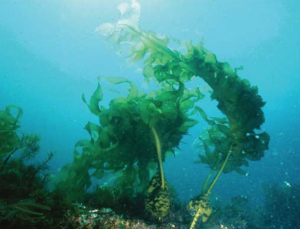By: Victoria Lueng | UTS Staff Writer| SQ Online 2016-17

A little boy bends over and looks intently at the green leafy plants scattered on the ground. “Look, mother, isn’t that the seaweed we eat during dinner?” The little boy grabs the seaweed by its root and runs up to his mother.
“Yes, it is. It’s delicious,” the mother replied. “Now put it back into the water where it belongs.” The boy runs back to the shore and throws the seaweed as far as he can into the calm waters of La Jolla Shores. Regarding his actions as harmless, the boy does not realize that he dispersed thousands of spores of the invasive species Undaria Pinnatifida, called Asian kelp, and better known as the seaweed that many families consider a staple to their diet.

Aquatic invasive species are species introduced to a new aquatic environment that have adapted, grown, and reprodued to a level that is harmful to the ecosystem and detrimental to the human economy. They are introduced to new environments by attaching to the hulls of recreational boats or cargo ships through a process known as hull fouling. Although many boat owners have painted copper on the bottom of their boats to prevent hull fouling, many of these species, including Watersipora subtorquata, Filograna implexa, and Hydroides spp., all invasive species to La Jolla Shores, can still strongly attach to the copper. Furthermore, when cruises and large cargo ships repeatedly collect and fill their ballasts with a large volume of water, they have acquired thousands of aquatic species that could potentially become invasive once the ballasts empty into new waters.

Boats are not the only way these non-native species are placed into a new ecosystem. Often, humans alter the ecosystem in such a way that is favorable to the growth of the aquatic invasive species. For example, breakwaters and groins, large man-made areas of sedimentary rock that stretch parallel or perpendicular to the shores, provide the perfect ecosystem for invasive species that prefer a sandy environment, including mussels and barnacles. The construction of additional ports allows more ships to arrive, and thus, more opportunities for aquatic invasive species to make a new home.
The impact of aquatic invasive species can be devastating. The increasing populations of invasive species decrease the available living space and the already limited resources for native species, reducing the overall biodiversity. Maintaining a diverse ecosystem is essential to providing a wide array of food sources and sustaining the existence of animals that kill pests that destroy the world’s food supply. Furthermore, many of these non-native species bring viruses and diseases that wipe out entire native species. For example, viral hemorrhagic septicemia (VHS) is an aquatic viral invasive species that attacks and weakens the blood vessels in fish, ultimately leading to death. This virus has affected up to 50 species of fish in southern Californian waters, disrupting the marine food chain.
Aquatic invasive species not only harm native species, but also ruin the human economy. By clogging water canals, invasive species inhibit the transportation of water to agricultural areas, ranches, and residences. Furthermore, the influx of aquatic invasive species crowd out native fish and animals that are staples to human diets, negatively affecting the seafood industry. Some densely populated invasive species have weighed down and damaged marine equipment including ship cables, hooks, and fishing gear. When non-native species cling onto the hull of boats, they create a “drag,” which increases the cost of gasoline required to travel.
The harmful consequences of 82 invasive species are manifested here in San Diego.

Native giant kelp forests compete with Undaria Pinnatifida for resources and sunlight. Undaria Pinnatifida has greatly reduced the existence of giant kelp forests which are essential to the San Diego Bay, because they provide a marine habitat for other wildlife, including kelp bass, Garibaldi fish, and sea otters. Eurasian zebra mussels, introduced to the area via recreational boats, overpopulate and disrupt the flow of water through water pipes and irrigation canals. Spotted jellyfish eat plankton, which the native fish and shrimp rely on for food. Hydroides, or tube worms, that thrive in the warm San Diego waters damage the paint coatings of many ships.
Scientists at UC San Diego, Scripps Institute of Oceanography, and other marine biological institutes have partnered to take steps to eradicate aquatic invasive species in the San Diego area. They have created La Jolla Underwater Park, a marine zone spanning 6000 acres between La Jolla Shores and La Jolla Cove, to preserve the precious native aquatic species that make their home here. By making it illegal to remove any part of the ecological reserve or disturb it with incoming boats, giant kelp forests can grow abundantly, fishes are not outsourced by invasive spotted jelly fish, and plants have plenty of sunlight.
Transported via ballast water or clinging on to hull bottoms, numerous invasive species have settled and thrived in La Jolla. These invasive species may seem harmless but their presence in La Jolla have disrupted the food chains, brought viruses that wipe out native species, damaged marine equipment and boats, and negatively impacted the human economy. Although eradicating aquatic invasive species is a long and exhausting process, it is worth the effort to preserve the beautiful native marine diversity in San Diego.

[hr gap=”0″]
Sources:
- http://anrcatalog.ucanr.edu/pdf/8359.pdf
- http://www.greenfacts.org/en/biodiversity/l-3/2-biodiversity-synthesis-report.htm#1p0
- http://ocean.si.edu/ocean-news/reducing-risk-transporting-invasive-species
- https://www.portofsandiego.org/environment/natural-resources/317-invasive-species.html
- http://www.sandiegocoastlife.com/attractions/san-diego-coast/reserves-la-jolla- underwater-park.html
- http://www.invasivespecies.wa.gov/priorities/viral_hemorrhagic.shtml
